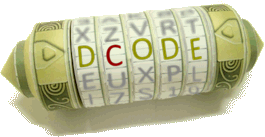Tool for decoding/encoding numbers via the Stibitz code also called Excess-3, a binary digital system similar to the BCD code, used by old processors coding each digit on 4 bits.
Excess-3 Code (Stibitz) - dCode
Tag(s) : Character Encoding
dCode is free and its tools are a valuable help in games, maths, geocaching, puzzles and problems to solve every day!
A suggestion ? a feedback ? a bug ? an idea ? Write to dCode!
Excess-3 Code (Stibitz)
Excess-3 Decoder/Converter
Excess-3 Encoder/Converter
Answers to Questions (FAQ)
What is Excess3 code? (Definition)
The code Excess-3 (also called Stibitz code and sometimes shortcut XS3 or XS-3) is a 4-bit binary decimal code (like the BCD) created to optimize some calculations in base 10 on older processors.
How to encrypt using Excess3 code?
The representation of a number in Excess-3 code is said to be biased because it has an offset of 3 (hence the 3 of XS-3) with the expected values and used by the conventional BCD code.
Example: 0 is coded 0011 in XS-3 whereas 0011 is 3 in BCD code.
The use of this offset allows a quick calculation trick for the complement to 9 (decimal) by inverting the bits, which is a big time saver for the calculation of subtractions by the processors.
Example: The digit 0 is coded 0011 in XS3 and its binary complement (inverting the 1's and 0's) is 1100 which corresponds to 9 in XS3.
The Decimal to Excess-3 conversion table/equivalence:
| Digit | Code XS-3 |
|---|---|
| 0 | 0011 |
| 1 | 0100 |
| 2 | 0101 |
| 3 | 0110 |
| 4 | 0111 |
| 5 | 1000 |
| 6 | 1001 |
| 7 | 1010 |
| 8 | 1011 |
| 9 | 1100 |
Example: 123 is coded 0100,0101,0110
The codes 0000 or 1111 are not used to represent numbers, which can be interesting in the sending of communication (the sequences of 0 and 1 are often representative of reading errors)
How to convert a number coded in Excess3?
Split the binary number into groups of 4 bits and replace each group with the corresponding number in the conversion table (above).
Example: 11001011 is split 1100,1011 and corresponds respectively to the numbers 9,8, so the conversion into decimal is 98
How to recognize an Excess3 coded number?
The code has a binary representation, it is not really distinguishable from another binary code (BCD, Gray, etc.) apart from its particularity to avoid sequences of more than 7 0000000 or 1111111.
Any reference to the old processors, calculators or electronic cash machines of the 70s is a clue.
When was Excess-3 invented?
George Stibitz created a calculating machine based on this principle in 1937.
Source code
dCode retains ownership of the "Excess-3 Code (Stibitz)" source code. Any algorithm for the "Excess-3 Code (Stibitz)" algorithm, applet or snippet or script (converter, solver, encryption / decryption, encoding / decoding, ciphering / deciphering, breaker, translator), or any "Excess-3 Code (Stibitz)" functions (calculate, convert, solve, decrypt / encrypt, decipher / cipher, decode / encode, translate) written in any informatic language (Python, Java, PHP, C#, Javascript, Matlab, etc.) or any database download or API access for "Excess-3 Code (Stibitz)" or any other element are not public (except explicit open source licence like Creative Commons). Same with the download for offline use on PC, mobile, tablet, iPhone or Android app.
Reminder: dCode is an educational and teaching resource, accessible online for free and for everyone.
Cite dCode
The content of the page "Excess-3 Code (Stibitz)" and its results may be freely copied and reused, including for commercial purposes, provided that dCode.fr is cited as the source.
Exporting the results is free and can be done simply by clicking on the export icons ⤓ (.csv or .txt format) or ⧉ (copy and paste).
To cite dCode.fr on another website, use the link:
In a scientific article or book, the recommended bibliographic citation is: Excess-3 Code (Stibitz) on dCode.fr [online website], retrieved on 2025-04-16,
